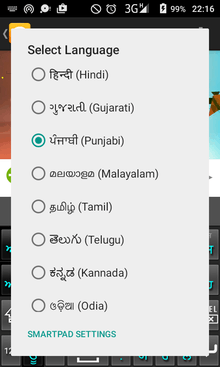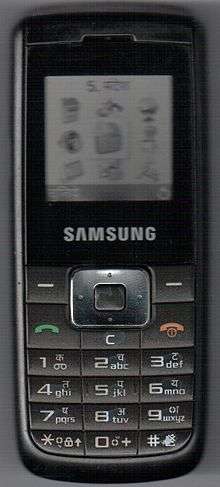Indic computing
Indic Computing means "computing in Indic" i.e. Indian Scripts and Languages. It involves developing software in Indic Scripts/languages, Input methods, Localization of computer applications, web development, Database Management, OCR, Spell checkers, Speech to Text and Text to Speech applications etc. in Indian languages.
Most of the Indic scripts nowadays use Unicode for working on Computers and Internet. In Unicode 5.0, Bengali, Devanagari, Gujarati, Gurmukhi, Kannada, Limbu, Malayalam, Oriya, Sinhala, Syloti Nagri, Tamil and Telugu scripts are encoded. Some more Indic scripts are in development and will be included in unicode, for instance Tulu Script.
A lot of Indic Computing projects are going on. They involve some government sector companies, some volunteer groups and individual people.
Government sector
TDIL
The Department of Electronics and Information Technology, India initiated the TDIL[1] (Technology Development for Indian Languages) with the objective of developing Information Processing Tools and Techniques to facilitate human-machine interaction without language barrier; creating and accessing multilingual knowledge resources; and integrating them to develop innovative user products and services.
In 2005, it started distributing language software tools developed by Government/Academic/Private companies in the form of CD for non commercial use.
Some of the outcome of TDIL program deployed on Indian Language Technology Proliferation & Deployment Centre. This Centre disseminate all the linguistic resources, tools & applications which have been developed under TDIL funding.
C-DAC
C-DAC is an India based government software company which is involved in developing language related software. It is best known for developing InScript Keyboard, the standard keyboard for Indian languages. It has also developed lot of Indic language solutions including Word Processors, typing tools, text to speech software etc.
BharateeyaOO.org
The work developed out of CDAC, Bangalore (earlier known as NCST, Bangalore) became BharateeyaOO.[2] OpenOffice 2.1 had support for over 10 Indian languages.
BOSS
BOSS is developed by National Resource Centre for free/open source software, an initiative of DIT. Its activities are coordinated by C-DAC Chennai and Anna University KBC Research Center. Support Centres are established at several cities in India to provide support to Users.
NGO and Volunteer groups
Indlinux
Indlinux[3] organisation helped organise the individual volunteers working on different indic language versions of Linux and its applications.
Sarovar
Sarovar.org is India's first portal to host projects under Free/Open source licenses. It is located in Trivandrum, India and hosted at Asianet data center. Sarovar.org is customised, installed and maintained by Linuxense as part of their community services and sponsored by River Valley Technologies. Sarovar.org is built on Debian Etch and GForge and runs off METTLE.
Pinaak
Pinaak is a non-government charitable society devoted to Indic language computing. It works for software localization, developing language software, localizing open source software, enriching online encyclopedias etc. In addition to this Pinaak works for educating people about computing, ethical use of Internet and use of Indian languages on Internet.
Ankur Group
Ankur Group is working toward supporting Bengali language (Bengali) on Linux operating system including localized Bengali GUI, Live CD, English-to-Bengali translator, Bengali OCR and Bengali Dictionary etc.[4]
SMC
SMC is a free software group, working to bridge the language divide in Kerala in the technology front and is today the biggest language computing community in India.[5]
Input methods

Full size keyboards
With the advent of Unicode inputting Indic text on computer has become very easy. A number of methods exist for this purpose, but the main ones are:-
InScript
Inscript is the standard keyboard for Indian languages. Developed by C-DAC and standardized by Government of India. Nowadays it comes inbuilt in all major operating systems including Microsoft Windows (2000, XP, Vista, 7), Linux and Macintosh.
Phonetic transliteration
This is a typing method in which, for instance, the user types text in an Indian language using Roman characters and it is phonetically converted to equivalent text in Indian script in real time. This type of conversion is done by phonetic text editors, word processors and software plugins. Building up on the idea, one can use phonetic IME tools that allow Indic text to be input in any application.
Some examples of phonetic transliterators are Xlit, Google Indic Transliteration, BarahaIME, Indic IME, Rupantar, SMC's Indic Keyboard and Microsoft Indic Language Input Tool. SMC's Indic Keyboard has support for as many as 23 languages whereas Google Indic Keyboard only supports 11 Indian languages.[5]
They can be broadly classified as:
- Fixed transliteration scheme based tools - They work using a fixed transliteration scheme to convert text. Some examples are Indic IME, Rupantar and BarahaIME.
- Intelligent/Learning based transliteration tools - They compare the word with a dictionary and then convert it to the equivalent words in the target language. Some of the popular ones are Google Indic Transliteration, Xlit, Microsoft Indic Language Input Tool and QuillPad.
Remington (typewriter)
This layout was developed when computers had not been invented or deployed with Indic languages, and typewriters were the only means to type text in Indic scripts. Since typewriters were mechanical and could not include a script processor engine, each character had to be placed on the keyboard separately, which resulted in a very complex and difficult to learn keyboard layout.
With the advent of Unicode, the Remington layout was added to various typing tools for sake of backward compatibility, so that old typists did not have to learn a new keyboard layout. Nowadays this layout is only used by old typists who are used to this layout due to several years of usage. One tool to include Remington layout is Indic IME. A font that is based on the Remington keyboard layout is Kruti Dev. Another online tool that very closely supports the old Remington keyboard layout using Kruti Dev is the Remington Typing tool.
Braille
IBus Sharada Braille, which supports seven Indian languages was developed by SMC.[5]
Mobile phones with Numeric keyboards


Mobile/Hand/cell phone basic models have 12 keys like the plain old telephone keypad. Each key is mapped to 3 or 4 English letters to facilitate data entry in English. For inputting Indian languages with this kind of keypad, there are two ways to do so. First is the Multi-tap Method and second uses visual help from the screen like Panini Keypad. The primary usage is SMS. 140 characters size used for English/Roman languages can be used to accommodate only about 70 language characters when Unicode[6] Proprietary compression is used some times to increase the size of single message for Complex script languages like Hindi. A research study[7] of the available methods and recommendations of proposed standard was released by Broadband Wireless Consortium of India (BWCI).
Transliteration/Phonetic methods
English is used to type in Indian languages. QuillPad[8] IndiSMS[9]
Native methods
In native methods, the letters of the language are displayed on the screen corresponding to the numeral keys based on the probabilities of those letters for that language. Additional letters can be accessed by using a special key. When a word is partially typed, options are presented from which the user can make a selection.[10]
Smart phones with Qwerty keyboards
Most smart phones have about 35 keys catering primarily to English language. Numerals and some symbols are accessed with a special key called Alt. Indic input methods are yet to evolve for these types of phones, as support of Unicode for rendering is not widely available.
For Smart Phones with Soft/Virtual keyboards
Inscript is being adopted for smart phone usage. For Android phones which can render Indic languages, Multiling Keyboard app[11] and plugin for Hindi (includes support for other indic languages)[12] are available.
Localization
Localization means translating software, operating systems, websites etc. various applications in Indian language. Various volunteers groups are working in this direction.
Mandrake Tamil Version
A notable example is the Tamil version of Mandrake linux. Tamil speakers in Toronto(Canada) released Mandrake, a GNU/Linux software, in coming out with a Tamil version.[13] It can be noted that all the features can be accessed in Tamil. By this, the prerequisite of English knowledge for using computers has been eliminated, for those who know Tamil.
IndLinux
IndLinux is a volunteer group aiming to translate the Linux operating system into Indian languages. By the efforts of this group, Linux has been localized almost completely in Hindi and other Indian languages.
Nipun
Nipun is an online translation system aimed to translate various application in Hindi. It is part of Akshargram Network.
Localising Websites
GoDaddy has localised its website in Hindi, Marathi and Tamil and also noted that 40% of the call volume for IVR is in Indian Languages.[14]
Indic blogging
Indic blogging refers to blogging in Indic languages. Various efforts have been done to promote blogging in Indian languages.
Social Networks
Some Social networks are started in Indian languages.[15]
Indic programming languages
- Programing using Hindi language
- BangaBhasha
- Ezhil, a programming language in Tamil
Software
Spell Checkers
Tangudu
Transliteration tools
Transliteration tools allows users to read a text in different script. As of now, Aksharamukha is the tool which allows most Indian scripts. Google also offers Indic Transliteration. Text from any of these scripts can be converted to any other scripts and vice versa. Whereas Google and Microsoft allow transliteration from Latin letters to Indic scripts.
Text-to-Speech
Carnegie Mellon University, in collaboration with the Hear2Read project, has developed a text-to-speech (TTS) software that helps the visually impaired listen to text in native Indian languages. Currently, Tamil is being offered and , releases in Hindi, Bengali, Gujarati, Marathi, Kannada, Punjabi and Telugu are expected over the remainder of 2016.[16]
Internationalized Domain Names
Operating Systems
Usage and Growth
According to godaddy, Hindi, Marathi and Tamil languages accounted for 61% of India's internet traffic.[14] It is to be noted that less than 1% of online content is in Indian languages. The newly created top apps are mostly Indian language or Indian language content ones. 61% of the Indian users of WhatsApp primarily use their native languages to communicate with it.[17]
See also
References
- ↑ "TDIL: Technology Development for Indian Languages Programme, India". Retrieved 28 March 2015.
- ↑ "BharateeyaOOo". Retrieved 28 March 2015.
- ↑ http://indlinux.org/>Indlinux
- ↑ "Archive of Ankur Home". Ankur group, Bengalinux.org group. Archived from the original on May 29, 2005. Retrieved 26 December 2015.
- 1 2 3 Helping Malayalam Take the Digital Leap - The New Indian Express
- ↑ "Quillpad Mobile - FAQs". Retrieved 28 March 2015.
- ↑ SIG Report on Indian Language SMS, Nov 2010
- ↑ "Quillpad Mobile - Hindi SMS application for your mobile phone". Retrieved 28 March 2015.
- ↑ "Eterno Infotech". Retrieved 28 March 2015.
- ↑ "Keypad for mobile-Keyboard for mobile-Keyboard for typing on mobile-Keypad for typing on mobile". Retrieved 28 March 2015.
- ↑ Honso. "MultiLing Keyboard - Android Apps on Google Play". Retrieved 28 March 2015.
- ↑ Honso. "Plugin Hindi हिन्दी - Android Apps on Google Play". Retrieved 28 March 2015.
- ↑ Frederick Noronha. "Indian-language computing: The long road ahead - Features - Technology". Retrieved 28 March 2015.
- 1 2 GoDaddy launches services in Hindi, Marathi and Tamil - EconomicTimes.com
- ↑ Google and Facebook’s attention to India might speed up Indic computing - Live Mint
- ↑ University, Carnegie Mellon (2016-08-03). "Android App Lets Visually Impaired in India Listen to Texts in Native Languages-CMU News". Carnegie Mellon University. Retrieved 2016-08-23.
- ↑ We haven’t yet built the Indian internet!